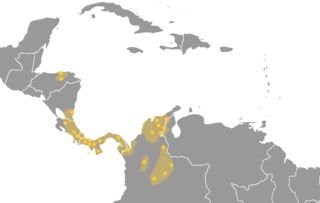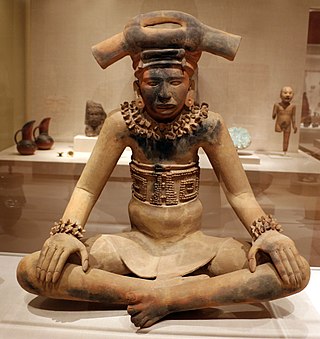
The Indigenous languages of the Americas are the languages that were used by the Indigenous peoples of the Americas before the arrival of non-Indigenous peoples. Over a thousand of these languages are still used today, while many more are now extinct. The Indigenous languages of the Americas are not all related to each other, instead they are classified into a hundred or so language families, as well as a number of extinct languages that are unclassified due to the lack of information on them.

The Chibchan languages make up a language family indigenous to the Isthmo-Colombian Area, which extends from eastern Honduras to northern Colombia and includes populations of these countries as well as Nicaragua, Costa Rica, and Panama. The name is derived from the name of an extinct language called Chibcha or Muysccubun, once spoken by the people who lived on the Altiplano Cundiboyacense of which the city of Bogotá was the southern capital at the time of the Spanish Conquista. However, genetic and linguistic data now indicate that the original heart of Chibchan languages and Chibchan-speaking peoples might not have been in Colombia, but in the area of the Costa Rica-Panama border, where the greatest variety of Chibchan languages has been identified.

The Totonac are an indigenous people of Mexico who reside in the states of Veracruz, Puebla, and Hidalgo. They are one of the possible builders of the pre-Columbian city of El Tajín, and further maintained quarters in Teotihuacán. Until the mid-19th century they were the world's main producers of vanilla.

The Chinantec or Chinantecan languages constitute a branch of the Oto-Manguean family. Though traditionally considered a single language, Ethnologue lists 14 partially mutually unintelligible varieties of Chinantec. The languages are spoken by the indigenous Chinantec people who live in Oaxaca and Veracruz, Mexico, especially in the districts of Cuicatlán, Ixtlán de Juárez, Tuxtepec and Choapan, and in Staten Island, New York.
The Ch'ol (Chol) language is a member of the western branch of the Mayan language family used by the Ch'ol people in the states of Chiapas, Tabasco, and Campeche in Mexico. This language, together with Chontal, Ch'orti', and Ch'olti', constitute the Cholan language group.

Uto-Aztecan, Uto-Aztekan or Uto-Nahuatl is a family of indigenous languages of the Americas, consisting of over thirty languages. Uto-Aztecan languages are found almost entirely in the Western United States and Mexico. The name of the language family was created to show that it includes both the Ute language of Utah and the Nahuan languages of Mexico.

The Huasteclanguage of Mexico is spoken by the Huastecos living in rural areas of San Luis Potosí and northern Veracruz. Though relatively isolated from them, it is related to the Mayan languages spoken further south and east in Mexico and Central America. According to the 2005 population census, there are about 200,000 speakers of Huasteco in Mexico. The language and its speakers are also called Teenek, and this name has gained currency in Mexican national and international usage in recent years.
The Totonacan languages are a family of closely related languages spoken by approximately 290,000 Totonac and Tepehua people in the states of Veracruz, Puebla, and Hidalgo in Mexico. At the time of the Spanish conquest Totonacan languages were spoken all along the gulf coast of Mexico. During the colonial period, Totonacan languages were occasionally written and at least one grammar was produced. In the 20th century the number of speakers of most varieties have dwindled as indigenous identity increasingly became stigmatized encouraging speakers to adopt Spanish as their main language.
The Nambikwara is an indigenous people of Brazil, living in the Amazon. Currently about 1,200 Nambikwara live in indigenous territories in the Brazilian state of Mato Grosso along the Guaporé and Juruena rivers. Their villages are accessible from the Pan-American highway.
Yuracaré is an endangered language isolate of central Bolivia in Cochabamba and Beni departments spoken by the Yuracaré people.
Yokotʼan (self-denomination), also known as Chontal Maya, is a Maya language of the Cholan family spoken in 2020 by around 60,000 Chontal Maya people of the Mexican state of Tabasco. According to the National Catalog of Indigenous Languages of Mexico-INALI, Yokotʼan has at least four dialects: Nacajuca (Central), Centla (Northern), Macuspana (Southern) and Tamulte (Eastern).
The Archive of the Indigenous Languages of Latin America (AILLA) is a digital repository housed in LLILAS Benson Latin American Studies and Collections at the University of Texas at Austin. AILLA is a digital language archive dedicated to the digitization and preservation of primary data, such as field notes, texts, audio and video recordings, in or about Latin American indigenous languages. AILLA's holdings are available on the Internet and are open to the public wherever privacy and intellectual property concerns are met. AILLA has access portals in both English and Spanish; all metadata are available in both languages, as well as in indigenous languages where possible.
Nambikwara is an indigenous language spoken by the Nambikwara, who reside on federal reserves covering approximately 50,000 square kilometres of land in Mato Grosso and neighbouring parts of Rondonia in Brazil. Due to the fact that the Nambikwara language has such a high proportion of speakers, and the fact that the community has a positive attitude towards the language, it is not considered to be endangered despite the fact that its speakers constitute a small minority of the Brazilian population. For these reasons, UNESCO instead classifies Nambikwara as vulnerable.
The Hyolmo are a people mainly from the Eastern and Northern Himalayan Regions of Nepal called Helambu. The residential area of hyolmo people are melamchi ghyang, tarkeghyang, naokte etc. They refer to themselves as the "hyolmo" or "Yolmopa" and are native residents of the Helambu valleys and the surrounding regions of Northeastern Nepal. Their combined population in these regions is around 11,000. They also have sizeable communities in Bhutan, Darjeeling, Sikkim and some regions of South-Western Tibet. They are among the 59 indigenous groups officially recognized by the Government of Nepal as having a distinct cultural identity and are also listed as one of the 645 Scheduled Tribes of India.
Frances Esther Karttunen, also known as Frances Ruley Karttunen, is an American academic linguist, historian and author.
Nora Clearman England was an American linguist, Mayanist, and Dallas TACA Centennial Professor at the University of Texas at Austin. Her research focused on the grammar of Mayan languages and contemporary Mayan language politics.
Huehuetla Tepehua is a moribund Tepehua language spoken in Huehuetla, northeastern Hidalgo, Mexico. There are fewer than 1,500 speakers left according to Susan Smythe Kung (2007).
Shobhana Chelliah is an Indian-American linguist who specializes in Sino-Tibetan languages. She is Distinguished Professor of Linguistics and Associate Dean of Research and Advancement at the College of Information, University of North Texas. Her research focuses on the documentation of the Tibeto-Burman languages of Northeast India.

The Totonac culture or Totonec culture was a culture that existed among the indigenous Mesoamerican Totonac people who lived mainly in Veracruz and northern Puebla. Originally, they formed a confederation of cities, but, in later times, it seems that they were organized in three dominions: North, South and Serran. Its economy was agricultural and commercial. They had large urban centers such as: El Tajín (300–1200), which represents the height of the Totonac culture, Papantla (900–1519) and Cempoala (900–1519).
Joel Fred Sherzer was an American anthropological linguist known for his research with the Guna people of Panama and his focus on verbal art and discourse-centered approaches to linguistic research. He co-founded the Archive of the Indigenous Languages of Latin America. Sherzer completed his Ph.D. at the University of Pennsylvania in 1968 and thereafter taught at the University of Texas at Austin for his entire career.







